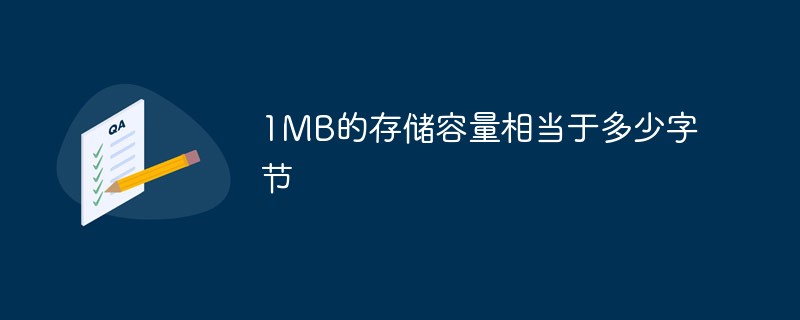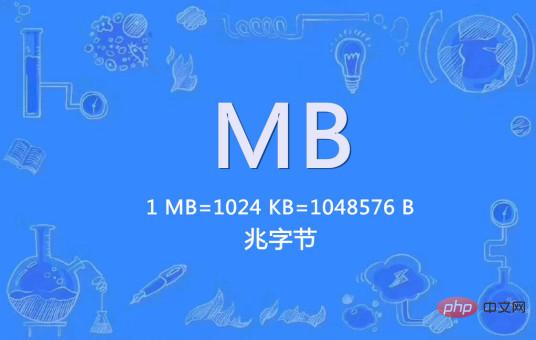1MB of storage capacity is equivalent to how many bytes
The storage capacity of 1MB is equivalent to 2 to the 20th power bytes, which is 1048576 bytes. MB is a storage unit in computers, pronounced as "mega"; because 1MB is equal to 1024KB, and 1KB is equal to 1024B (bytes), so 1MB is equal to 1048576 (1024 *1024) bytes.

The operating environment of this tutorial: Windows 10 system, Dell G3 computer.
1MB storage capacity is equivalent to 2 to the 20th power bytes.
1MB=1024KB
1KB=1024B
1MB=1024 * 1024 =1048576B
MB is English" The abbreviation of "MByte" is a storage unit in computers, pronounced "mega".
MB and Mb (note the capitalization of the B letter) are often mistaken for the same meaning. In fact, MByte means "megabyte" and Mbit means "megabit". MByte refers to the number of bytes, and Mbit refers to the number of bits. Although the "Byte" in MByte has the same translation as the "bit" in Mbit, both are bits and are units of data measurement, but they are completely different. Byte is the "number of bytes" and bit is the "number of bits". In computers, every eight bits is one byte, that is, 1Byte=8bit, which is a 1:8 correspondence. Therefore, when writing units, be sure to pay attention to the capitalization and meaning of the letter B.

Conversion
MB or MiB can be Mebibyte, that is, 2 to the 20th power = 1,048,576 Bytes (Byte) Megabyte , or 106 = 1,000,000 Bytes (Byte)
Mbit or Mibit can be Mebibit, that is, 2 to the 20th power = 1,048,576 bits (bit) Megabit, or 106 = 1,000,000 bits (bit)
Expand knowledge:
Byte (Byte) is a unit of measurement used by computer information technology to measure storage capacity. It also represents a unit of measurement in some computer programming languages. Data types and language characters.
One byte stores an 8-bit unsigned number, and the stored value range is 0-255. Like characters, byte type variables only require one byte (8 bits) of memory space to store.
Byte is the unit of binary data. A byte is usually 8 bits long. However, some older computer architectures use different lengths. To avoid confusion, in most international literature the word byte is used instead of byte. In most computer systems, a byte is an 8-bit unit of data. Most computers use a byte to represent a character, number, or other character. A byte can also represent a series of binary bits. In some computer systems, 4 bytes represent a word, which is the unit of data that the computer can efficiently process when executing instructions. Some language descriptions require 2 bytes to represent a character, which is called a double-byte character set. Some processors are capable of handling double-byte or single-byte instructions. Bytes are often abbreviated as "B" and bits are often abbreviated as lowercase "b". The size of computer memory is usually expressed in bytes.
Related units:
-
B and bit
Data storage is in "byte" (Byte), and data transmission is mostly in " "Bit" (also known as "bit") is the unit. One bit represents a 0 or 1 (that is, binary). Every 8 bits (bit, abbreviated as b) constitute a byte (Byte, abbreviated as B). It is the smallest level of information unit.
-
Word (Word)
In a computer, a string of numbers that are processed or calculated as a whole is called a computer word, or word for short. Words are usually divided into bytes (each byte is usually 8 bits). In memory, each cell typically stores one word. Therefore each word is addressable. The length of a word is expressed in bits.
-
Word length
The number of bits contained in each word of a computer is called the word length. The calculated word length refers to the number of binary digits it can process at one time. . Generally, the word length of large computers is 32-64 bits, that of small computers is 12-32 bits, and that of microcomputers is 4-16 bits. Word length is an important factor in measuring computer performance.
For more related knowledge, please visit the FAQ column!
The above is the detailed content of 1MB of storage capacity is equivalent to how many bytes. For more information, please follow other related articles on the PHP Chinese website!

Hot AI Tools

Undresser.AI Undress
AI-powered app for creating realistic nude photos

AI Clothes Remover
Online AI tool for removing clothes from photos.

Undress AI Tool
Undress images for free

Clothoff.io
AI clothes remover

AI Hentai Generator
Generate AI Hentai for free.

Hot Article

Hot Tools

Notepad++7.3.1
Easy-to-use and free code editor

SublimeText3 Chinese version
Chinese version, very easy to use

Zend Studio 13.0.1
Powerful PHP integrated development environment

Dreamweaver CS6
Visual web development tools

SublimeText3 Mac version
God-level code editing software (SublimeText3)

Hot Topics
 1376
1376
 52
52
 How many MB is 1g of memory?
Mar 16, 2023 pm 04:19 PM
How many MB is 1g of memory?
Mar 16, 2023 pm 04:19 PM
1g memory is 1024MB. g stands for "GB", which means "gigabyte" in Chinese, and MB refers to "megabyte"; GB and MB are both commonly used to indicate the storage capacity of computer hard drives, memories and other storage media with larger capacities. The conversion rate between GB and MB is approximately equal to 1000 (1024), that is, "1GB=1024MB".
 1MB of storage capacity is equivalent to how many bytes
Mar 03, 2023 pm 05:42 PM
1MB of storage capacity is equivalent to how many bytes
Mar 03, 2023 pm 05:42 PM
1MB of storage capacity is equivalent to 2 to the 20th power bytes, or 1,048,576 bytes. MB is a storage unit in computers, pronounced as "mega"; because 1MB is equal to 1024KB, and 1KB is equal to 1024B (bytes), so 1MB is equal to 1048576 (1024 *1024) bytes.
 How many bytes does 128mb mean?
Nov 29, 2022 am 10:35 AM
How many bytes does 128mb mean?
Nov 29, 2022 am 10:35 AM
128mb refers to 134217728 bytes; the byte conversion formula is "1MB=1024KB=1048576B=8388608bit", which means that 1048576 English letters and 524288 Chinese characters can be saved; the traffic unit conversion formula is 1GB=1024MB, 1MB=1024KB, 1KB= 1024B.
 1 bit equals how many bytes
Mar 09, 2023 pm 03:11 PM
1 bit equals how many bytes
Mar 09, 2023 pm 03:11 PM
1 bit is equal to one-eighth of a byte. In the binary number system, each 0 or 1 is a bit (bit), and a bit is the smallest unit of data storage; every 8 bits (bit, abbreviated as b) constitute a byte (Byte), so "1 byte ( Byte) = 8 bits”. In most computer systems, a byte is an 8-bit (bit) long data unit. Most computers use a byte to represent a character, number, or other character.
 1g equals how many MB of memory capacity
Feb 03, 2023 pm 03:55 PM
1g equals how many MB of memory capacity
Feb 03, 2023 pm 03:55 PM
1g is equal to 1024MB memory capacity. The full name of g is "GB", which means "gigabyte" in Chinese. It is a decimal unit of information measurement and is often used to indicate the storage capacity of computer hard drives, memories and other large-capacity storage media. The conversion rate between GB and MB is approximately equal to 1000 (1024), that is, "1GB = 1024MB".
 How many bytes does one ascii character occupy?
Mar 09, 2023 pm 03:49 PM
How many bytes does one ascii character occupy?
Mar 09, 2023 pm 03:49 PM
One ascii character occupies 1 byte. ASCII code characters are represented by 7-bit or 8-bit binary encoding in the computer and are stored in one byte, that is, one ASCII code occupies one byte. ASCII code can be divided into standard ASCII code and extended ASCII code. Standard ASCII code is also called basic ASCII code. It uses 7-bit binary numbers (the remaining 1 binary digit is 0) to represent all uppercase and lowercase letters, and the numbers 0 to 9. Punctuation marks, and special control characters used in American English.
 How many bytes do utf8 encoded Chinese characters occupy?
Feb 21, 2023 am 11:40 AM
How many bytes do utf8 encoded Chinese characters occupy?
Feb 21, 2023 am 11:40 AM
UTF8 encoded Chinese characters occupy 3 bytes. In UTF-8 encoding, one Chinese character is equal to three bytes, and one Chinese punctuation mark occupies three bytes; while in Unicode encoding, one Chinese character (including traditional Chinese) is equal to two bytes. UTF-8 uses 1~4 bytes to encode each character. One US-ASCIl character only needs 1 byte to encode. Latin, Greek, Cyrillic, Armenian, and Hebrew with diacritical marks. , Arabic, Syriac and other letters require 2-byte encoding.
 How many bytes does an ascii code occupy?
Sep 07, 2023 pm 04:03 PM
How many bytes does an ascii code occupy?
Sep 07, 2023 pm 04:03 PM
An ASCII code occupies one byte. ASCII code is a coding standard used to represent characters. It uses 7-bit binary numbers to represent 128 different characters, including letters, numbers, punctuation marks, special characters, etc. A byte is the basic unit of computer storage unit. It consists of 8 binary bits. Each binary bit can be 0 or 1. One byte can represent 256 different values, so it can represent all characters in the ASCII code.



